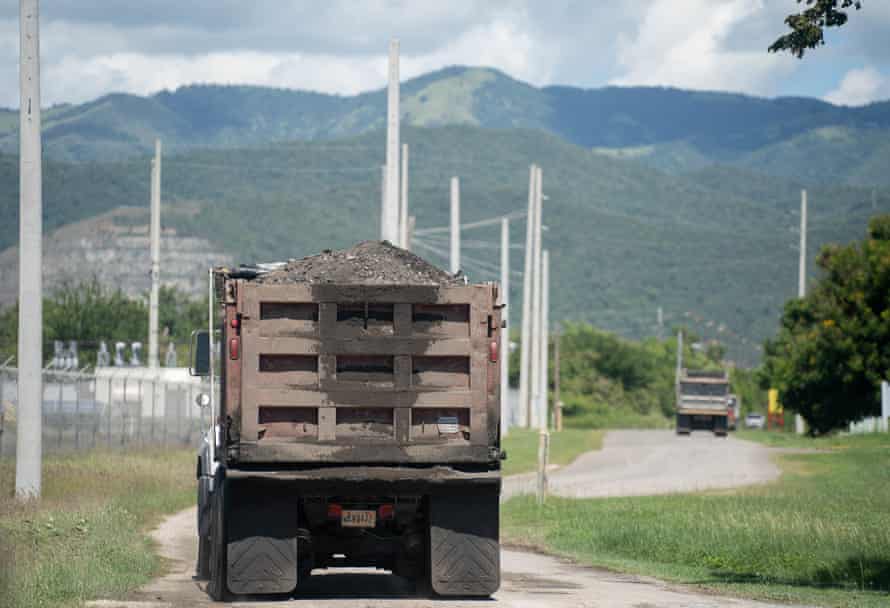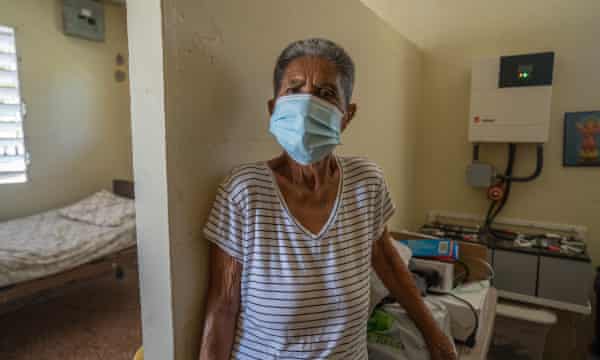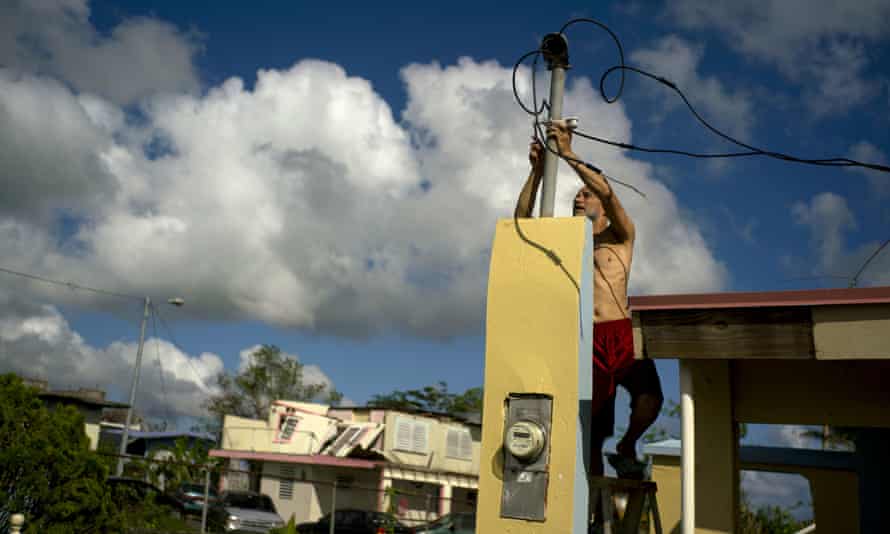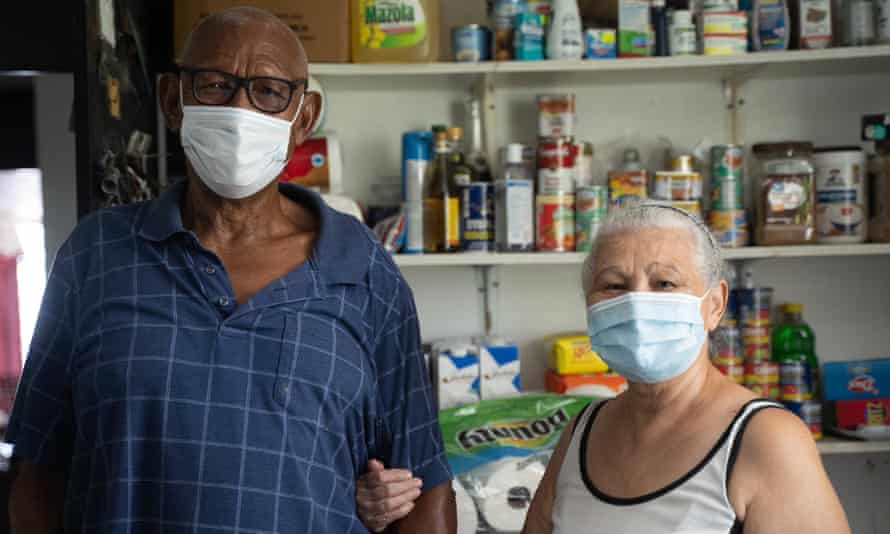‘We want sun’: the battle for solar power in Puerto Rico

Many people suffered following power cuts in the aftermath of two hurricanes, but advocates say solar power will withstand future disasters
Last modified on Mon 18 Oct 2021 14.02 EDT
Rosalina Marrero spends the best part of each day ironing and watching telenovelas at her modest bungalow in Puerto Rico’s coastal Guayama province. When it gets too hot or her asthma plays up due to the toxic coal ash from the nearby power plant, the 78-year-old widow rests on an adjustable hospital bed, clicks on the fan and thanks God for the solar panels on her roof.
Earlier this year, Marrero was among two dozen residents in a low-income, predominantly Black neighbourhood blighted by coal pollution, fitted with a rooftop solar and storage system. Campaigners say systems like hers should be rolled out more widely to tackle the island’s energy crisis and the global climate emergency – both of which are exacerbating racialized health inequalities.
The situation with the electricity is dire.
Puerto Ricans pay more than twice as much for electricity as Americans on the mainland yet earlier this month power cuts to hundreds of thousands of homes and businesses caused widespread anger and misery. Traffic lights failed, hospitals used expensive diesel generators to keep dialysis machines and ventilators running, and fires broke out due to fluctuations in voltage.
Despite the abysmal service, electricity rates have increased four times so far this year.
In hot and humid Guayama, the lights went out for several hours almost every day for those unable to afford a backup generator. But thanks to the rooftop solar system, Marrero could stay cool and watch TV without worrying about the food going off in the fridge.
“It’s the best thing that’s happened to me. I thank God because my poor neighbours are suffering but I’ve always got electricity. I feel more secure, if we get another big hurricane like Maria, I won’t suffer so much,” said Marrero.
Marrero is lucky because while Puerto Rico gets enough sunlight to meet its residential electricity needs at least four times over, less than 3% of the island’s energy comes from renewable sources. The rest is generated from imported fossil fuels: 49% from petroleum and 29% from natural gas, while coal accounts for 19%.

Hurricane Maria was a wake-up call: it not only exposed Puerto Rico’s vulnerability to extreme weather events linked to global heating, but also focused attention on the economic and environmental ramifications of the island’s dependence on fossil fuels for local communities and greenhouse gas emissions.
This gave rise to a social movement that came up with a plan called Queremos Sol, or we want sun – an evidence-based roadmap to make Puerto Rico’s energy system self-sufficient by swapping fossil fuels for onsite small solar grids distributed throughout the island.
The concept is simple: a localized system that doesn’t require moving electricity from centralized power plants along overhead wires to local substations would be better equipped to withstand and recover from super storms and other natural disasters. Onsite batteries would better cover critical needs during disruptions.
Experts say that such radical change is necessary to comply with Puerto Rico’s ambitious energy policy, which mandates that 40% of electricity must come from renewable resources by 2025 and 100% by 2050.

It would also help the US comply with the Paris agreement, which Biden rejoined on the first day of his presidency, as well as the administration’s commitment to achieve net zero emissions by investing in green infrastructure and jobs to address climate change and environmental justice.
On the other hand, local authorities and the energy sector insist that more electricity must be generated to avoid shortages and power cuts – claims which campaigners dismiss as a ruse to justify further investment in gas and transmission infrastructure, as official documents suggest there’s enough capacity to cover demand.
What’s agreed is that Puerto Rico is at a pivotal point and for once there’s real money on the table: last September, the Federal Emergency Management Agency (Fema) approved an unprecedented $9.6bn to reconstruct the island’s energy system and is currently deciding how the money should be spent.
“Rooftop solar could supply all of Puerto Rico’s energy needs. It’s viable, sustainable and more reliable than the current centralized system that the energy industry and authorities want to rebuild,” said Ruth Santiago, lawyer and environmental policy expert who contributed to Queremos Sol. “We need the Biden administration to act. This is a critical time, a lot is at stake.”
A move to renewables – but how fast?
Puerto Rico is a tropical Caribbean archipelago and US territory located a thousand miles or so south-east of Miami. The main island is mostly mountains surrounded by narrow coastal plains where the majority of the 3 million habitants reside in towns and cities.
Over the past two decades, Puerto Rico has been among three territories (along with Haiti and Myanmar) most affected by extreme weather such as storms, floods, heatwaves and droughts, according to the Germanwatch Climate Risk Index.
In September 2017 hurricanes Irma and Maria made landfall two weeks apart and destroyed much of Puerto Rico’s electricity transmission and distribution infrastructure (including industrial wind farms), leading to the longest blackout in US history.
About 3,000 people died in the aftermath as homes, businesses and healthcare facilities were left without power for months. Marrero was cut off for about 15 weeks, and recalls having to buy just enough food to last each day as she couldn’t afford a generator for the fridge or fan.
In addition to increasingly frequent and intense catastrophic weather events, global heating is also causing slower changes such as rising sea levels and ocean warming that endanger the island’s infrastructure.

But the climate crisis isn’t the only threat facing Puerto Rico: a 6.4 magnitude earthquake in January 2020 left two-thirds of residents without power, and significantly damaged the island’s two gas-fired power plants.
In fact, much of the existing energy infrastructure (plants, transmitter towers, poles and cables) is in flood-prone areas or at risk of sea-level rise, storm surges and tsunamis, as well as strong winds and earthquake damage.
It’s one reason why rooftop systems, not industrial farms, are proposed by Queremos Sol – as centralised renewable plants also rely on transmission and distribution lines. Rooftop solar relies on batteries and local distribution networks, which would be easier to fix if damaged. In addition, Puerto Rico lacks open land, so large-scale wind and solar farms would affect scarce agricultural lands and ecologically sensitive areas.
It’s widely agreed that Puerto Rico’s energy system is in disarray.
The publicly owned utility (Prepa), like Puerto Rico, is in bankruptcy and maintenance has been neglected for years. The latest spate of power cuts led to resignations at the top of Prepa, which is responsible for generating electricity, and angry public protests against Luma, the private US-Canadian consortium that took over transmission and distribution in June.
What’s disputed is how quickly the island should move to renewables.
Official documents show the government of Puerto Rico, Prepa and Luma want to spend most of the historic funds from the Federal Emergency Management Agency (Fema) on rebuilding the existing transmission system and new gas-fired plants, with only a fraction left over for renewables.
Fema told the Guardian that Prepa and Luma have so far submitted 88 projects, but detailed work plans would be evaluated before final approval.
Fernando Gil, the new chairman of Prepa’s board, told the Guardian that progress towards the legally binding renewable targets had been too slow, but denied vested interests were to blame. “We need to stabilize the system, generate more power and be proactive with maintenance while planning for renewables, but we have to be flexible … Gas is way cleaner and can be more efficient if combined with other fuels.”
Yet Tomas Torres, the consumer representative on the board, said the utility should be investing in rooftop solar installation now. “Puerto Rico has the proper laws, regulations and funds to achieve energy transformation, it just has to be executed.”
A Luma spokesperson said: “By key measures including reliability, customer service and safety, Puerto Rico has the worst electrical service in North America. It will take time and concerted effort to set it right.”
As the battle for Puerto Rico’s energy future intensifies, for many ordinary people it’s a matter of life and death.
Solar power ‘can save lives’
In Guayama, 72-year-old Margarita Velazquez was diagnosed with COPD, a chronic respiratory condition, a few years after the nearby coal plant opened in 2002. “I stopped being able to breathe. I remember the doctor asked me how long I’d been smoking for, but I’ve never smoked!”
On bad days, when coal ash hovers in the air over the community, Velazquez finds it hard to stop wheezing and needs an electric-powered nebulizer machine to open up her airways. The anxiety of losing power has gone since she was selected for the rooftop project.

“It’s given me some peace of mind,” she said.
At the nearby plant, a huge pile of grey ash laden with toxic heavy metals is waiting to be shipped to Florida and Georgia for disposal. When the wind picks up, the ash scatters through the air.
For years hundreds of thousands of tonnes were dumped in landfills, roads and fields, contaminating the air and drinking water sources of mostly low-income neighborhoods.
The coal plant has cost lives. Public health researchers have found higher rates of several chronic conditions among communities near the plant, including respiratory illness, heart disease, allergies and skin complaints. The incidence of cancers increased by 65% in the decade after the plant opened, while the numbers of patients with kidney failure requiring dialysis have also risen, according to Dr Gerson Jimenez, director of the Guayama hospital where he has worked for more than four decades.
Amid growing backlash, the coal ash must now be removed, but huge toxic deposits remain scattered across the island and now others face the same deadly consequences. “It’s now being sent to poor communities of colour on the mainland, who can expect to see an increase in the same lethal diseases in years to come,” said Jimenez.
Puerto Rico’s energy reforms, passed in 2019 with bipartisan support, mandate phasing out coal by 2028 (the company’s 25-year contract ends in 2027), but advocates argue that rolling out rooftop solar could make the plant obsolete sooner and therefore save lives.
Jose Vazquez, 76, Velazquez’s husband and a member of Guayama Community United for Your Health – a group campaigning for the plant’s closure, cleanup and compensation – said: “There are big politicians and big interests in this struggle. We are in the middle like ham in a sandwich.”
Perhaps there is another way.

Solar town
Adjuntas is a small mountain town surrounded by lush forests in the central midwestern part of the island where the temperate climate provides relief from the steamy coasts.
Here, the solar power movement dates back more than two decades to a grassroots environmental group called Casa Pueblo, which organized the community to kick out a mining company before embarking on a crusade to make the town energy independent.
Since Maria, hundreds of rooftop and onsite solar systems have been installed at homes, emergency services and critical businesses around Adjuntas, known locally as Pueblo Solar (Solar Town).
The initiative relies on locally trained volunteers, donations and grants from groups like the US non-profit Honnold Foundation, and includes vulnerable households, a nursing home, fire station, community radio station and selection of general stores which serve isolated neighbourhoods stranded after the hurricanes.
At the town’s picturesque main square, all 25 businesses – including a pizzeria, a pharmacy and hardware store – have created a micro energy network with a social justice twist: savings from generating and sharing their own energy will help fund solar systems for low-income residents who are homebound or need to keep medication refrigerated.
On the edge of town, Jose Hernandez runs a minimart which Maria partially destroyed and left without power for six months. The hurricane triggered a mass exodus to the mainland of mostly working-age folks left unemployed or homeless, but Hernandez, 33, decided to stay and rebuild.
It has been hard to expand the business as frequent power cuts force him to close the store and also damage the fridges, which are costly to repair.
But six months ago Hernandez obtained a grant for solar panels, and then used his savings to buy the other equipment. Since then, he has had uninterrupted power and his electricity bill has fallen drastically, allowing him to hire an employee. “It’s given me a sense of tranquillity. It’s exciting, I can now expand and invest in my future.”
At its heart, this is a social justice initiative seeking to democratise access to energy, according to Arturo Massol from Casa Pueblo. “It’s anti-poverty, locally driven development as we believe clean renewable energy is a right for everyone, not just the privileged few.”

